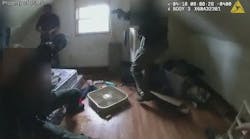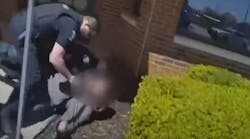Most every law enforcement agency understands the inherent value of making less-lethal force options available to their first responders. Less-Lethal force options are no longer found only in specialty and SWAT teams. Tools such as Specialty Impact Munitions (bean bag rounds, sponge rounds, and Pepperball), Electronic Control Devices (TASER), Chemical Irritants (OC and CS), and even blast ball grenades are now providing patrol officers with reasonable options to overcome resistance, enhance safety for both Officers and offenders, and de-escalate situations.
While these force options offer significant advantages, any action taken by law enforcement to overcome suspect resistance is subject to scrutiny and liability. Law enforcement trainers, investigators and administrators can all take steps to proactively reduce that liability.
Trainers and administrators must start by selecting the right tools for the job. The reality is that all currently available less-lethal tools have advantages and limitations. No one tool can be the answer to every situation or even for every officer. Unfortunately the limitations are often not fully understood by the end user (the operator actually deploying the tool). Quality instruction is frequently available from reputable manufacturers, but this does not always cover all issues relevant to real-world field use of these devices. In addition to the "ideal" method for employing a selected less-lethal force option, users need to consider limitations of the tool and available alternatives. Officers need to understand the need to thoroughly document and articulate the reasonableness of the force option selected.
When considering the implementation of a less-lethal tool, reasonable precautions can be taken:
- Structured testing of products prior to implementation and training
- Proper training of operators and supervisors
- Post event preservation
- documentation of the event
- collection and analysis of Less-lethal evidence
- wound or injury documentation and documentation of aftercare
Addressing these topics can greatly reduce risk, lawsuit payouts, and increasing overall public safety on several levels.
Pre-Event Testing and Evaluation
ECD (TASER)-OC Flammability
During the past several years, there have been occurrences across the U.S. where a substance on a person has been ignited during a TASER ECD deployment. Some events have been documented, while others are anecdotal.
One fact remains true: Under the right circumstances, a flammable substance can ignite during an ECD exposure. This has resulted in unintended suspect injury. Flammable substances include gasoline, alcohol, hair products, and some chemical irritant sprays such as OC (Oleoresin Capsicum). While Officers cannot always predict or control the presence of flammable substances introduced by the suspect or the environment, law enforcement agencies can select chemical irritant sprays that do not ignite with the application of a TASER.
Long gone are the days of taking a can out to the precinct parking lot, spraying it on some TASER probes laying on the ground and declaring the product as "safe". Structured, realistic testing of chemical agents during the selection process can greatly reduce or even eliminate problems during actual deployments. Not all sprays are created equally, nor can you necessarily trust the label. The old standard: the rep says this is hotter than hell and don't worry, it's water based are not adequate. We have encountered a number of OC sprays that state "Non-Flammable" or "EDW tested and safe" on the product label that ignited and rapidly burned with a TASER as the ignition source. The safety claims are frequently based upon EPA flame-extension and flash point testing that has little or nothing to do with law enforcement use of the product.
In 2004, CRT developed a protocol for testing the flammability potential of chemical agents when used in conjunction with ECD. This protocol has been published and shared through multiple outlets.
Our protocol was designed to create a worst case, or most likely to ignite scenario. Little or no liability is incurred when everything goes as intended. It is when things go wrong, in the worst case, that officers and agencies need their products to perform as designed. Our results were surprising with some brands instantly setting our testing mannequin ablaze. Some responsible manufacturers have reformulated the chemical makeup of their sprays as a direct result of our testing.
SIM (Specialty Impact Munitions)
Specialty Impact Munitions are simply defined as launchable batons/projectiles designed to inflict blunt trauma (pain compliance) and/or dysfunction at a distance. The most common SIM in use today is the 12 Gauge beanbag. Although many appear similar, the wound profiles on the body from impact vary. In 2002, as a response to a local agency request, CRT began pre-deployment testing of less-lethal impact munitions. Our goal was to evaluate currently available tools to better understand the amount of force delivered (capabilities), and wound potential so that officers could make a more reasonable and knowledgeable use of force decision. We quickly found that some types of rounds did not perform consistently. Some claims made by manufacturers were not reflected in the testing, and it became clear that the old measure of energy in foot/pounds really did not correlate to effectiveness or relative safety.
Most of the manufacturer data available relies heavily on kinetic energy transferred (weight/mass and speed of the projectile) without taking into account the degree to which the energy is focalized into the tissue, or the size and character of the impact surface. CRT developed a testing model that utilized 10% ballistic gelatin and MBM ballistic soap. After observing and documenting the energy transfer of SIM rounds into the test media, CRT was able to compare the controlled media tests to a limited number of controlled human tests. The documented outcome of the human tests validated the media model.
No round that is designed to cause blunt trauma and pain can ever be considered completely non-lethal and risk free. Prior to any deployments in the field each impact munition should be objectively evaluated to insure the round performs as expected under a variety of conditions. Understanding the performance of the round, under realistic conditions can greatly reduce agency liability, and increase the reasonableness of using these tools under the right conditions. Gone are the days of just shooting a few rounds into a piece of plywood, or at a metal drum.
Training
When Officers are trained to fight, and use empty handed control techniques, they are encouraged to test themselves to find their strengths and limitations. They are taught a variety of techniques for use in different situations, because officers do not get to choose where they fight and with whom. Not all officers fight the same way.
When officers are taught to drive under pursuit and emergency conditions, they are encouraged to test themselves to find their strengths and limitations as well as the abilities and limitations of their equipment. A quality driver training program will allow officers to train under a variety of lighting and weather conditions, because in reality officers do not get to choose where and when they will be called upon to drive under emergency conditions. Not all officers drive the same way.
Less-Lethal force application is no different. Officers need to learn more than just the ideal-way to employ less-lethal technology. Not every suspect will be standing still, at the ideal range, with good lighting when the need arises to control them and overcome resistance. Officers need to understand how their round will perform if the suspect presents them with a situation where they have to engage at a closer than recommended distance, or if they strike a target on the body other than a primary target. All officers understand the balancing act that is a reasonable use of force. The act of subduing a non-compliant suspect is never pretty. Officers must be provided with realistic information about the technology they available in order to use it in a reasonable manner, and articulate why the choice was appropriate under the conditions.
It is also important that the officer's chain of command be trained on the realistic capabilities and limitations of the technology in use. Too often the impressions of current police technology are shaped more by Hollywood and television than reality.
Post Event Evaluation
Excessive force complaints and in-custody deaths have long been challenges for the law enforcement community. Regardless of the circumstances, the agency, as the last entity in contact with the person, is held suspect. One area where most agencies can improve is in the post event documentation and analysis of the evidence related to the event. Forensic reconstruction of a less lethal event is not only possible, is it to some extent expected in today's CSI-educated society. The investigator must be familiar with the device, the training, tactics, and resulting evidence related to a particular less-lethal force option.
SIM deployments can produce wadding and other materials released with the round. This evidence can provide clues as to the brand and the distance fired. The person responsible for evaluating the scene should have a realistic understanding and expectation of how the round is expected to perform, and the expected wound profile on the subject.
In 2001, the Washington State Patrol crime lab developed forensic testing protocols for ECD (TASER) evidence following a several high profile incidents in the Seattle area. In 2002, CRT adopted and further refined these protocols for use for independently testing TASER evidence. Analysis includes the ECD unit, cartridge, wires and probes to reconstruct the incident. It is recommended that jurisdictions have a post-event ECD protocol in place. Operators, supervisors and investigators need to have realistic expectations of the device function. In those cases where an outcome is different than intended or expected, the cause of a failure can often be diagnosed if the situation is documented thoroughly, and relevant evidence is collected and preserved for analysis.
Know Your Experts
In the event that your incident leads to a civil law suit, agencies should prepare for opposing expert witnesses. There are a slew of under-qualified and ill-informed experts that have very little field application, practical research, or post event reconstruction experience in less-lethal deployments. Thorough inquiries when these experts are disclosed can prove valuable in successfully impeaching these witnesses before and during trial. These experts, however, can quickly become a formidable adversary when selection, training, and post event analysis of your agency’s less-lethal platforms were not conducted properly.


